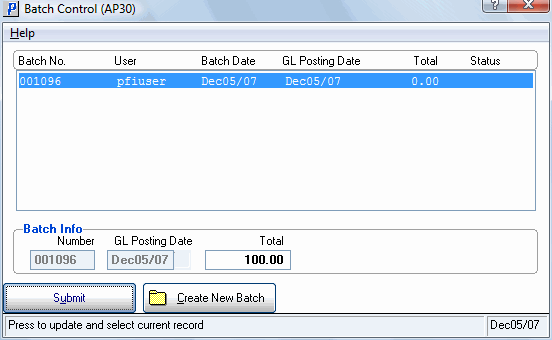Batch Control (AP30)
The Batch Control (AP30) screen is designed to ensure that the transactions recorded in Enter Invoices (AP30) accurately reflect their source documents. When the Batch Control program runs, the Batch Control list automatically displays allowing you to create a new Batch or select an existing Batch.
Creating a New Batch:
- Click on Create New Batch.
- The GL Posting Date automatically populates with the system date when this date is within the Current or Next fiscal periods for AP (as updated by AP89). If the date is outside of these periods, then the date defaults to either the 1st day of the Current period or the last day of the Next period. You can Tab through this field to accept the current date or you can enter/select from the query a new date. This date is the default GL Posting Date for all Invoices in this batch.
Note: The date entered must be within the current fiscal period or within the next fiscal period. Future Invoices will generate GL postings based on the date of the Future Invoice, not on the GL Posting Date.
- The GL Posting Date displays in the Header section of AP30. If one or more Invoices in the Batch are to be distributed to the GL with a different date than others in the Batch, then the GL Posting Date can be changed. For example, if some of the Invoices are for the current fiscal period and others are for the next fiscal period, then the GL Posting Date can be changed accordingly in the Header section of AP30.
- Enter the sum of the Invoice totals, regardless of their currency, for the current batch of Invoices in the Total field. This total may be negative or positive.
- Click on Update and Proceed to continue creating the new Batch. The following message displays: "You are using batch # xxxxxx. OK". Click OK to close the message window and AP30 automatically opens.
Using an Existing Batch:
- From the Batch No. list box, highlight the Batch with which you want to work. The Batch No. list box contains the following fields:
- Batch No. - the Batch Number that was assigned when the Batch was created.
- User - the Operator ID logged into Enterprise when the Batch was created.
- Batch Date - the Batch Date is the PointForce Enterprise System Date on the day the Batch was created.
- GL Posting Date - the GL Posting Date is the date that the Invoice will be journalized. This is the default GL Posting Date for all Invoices in this Batch, but if you need to use multiple posting dates within the same batch, the GL Posting Date field can be changed from Invoice to Invoice.
- Total - the Batch Total is the sum of all transactions to be entered into the Batch, regardless of their currency. The total can be express in mixed currency as it is only a control total. This field is used to prove the accuracy of the entered transactions against the sum of their source documents.
- Status - the Status displays the Operator ID of the operator currently using the the Batch. This field is blank if the Batch is not currently in use by another Operator.
- If an existing Batch is already in use by another operator, the following message displays: "Batch is in use by Operator ID. Select another batch. OK". Click OK
to close the message window.
- If an existing Batch is already in use by your Operator ID, the following message displays: "Batch xxxxxx is in use. Are you sure you want this batch? Yes/No". Select No to cancel the request. Select Yes to open the Batch.
- Caution: If you open the Batch a second time and try to access the same Invoice record that is already open, the following message displays: "Open invoice record ###### is locked by Operator ID (AP30) mmddyy hhmmss. You are not allowed access at this time. If your operator code is listed above, check the Windows Taskbar on your PC to see if you are running a second copy of AP30 and end the program. If another operator has set the lock, ask them to complete the update. If no one is running program AP30 listed above, then the PC running the program must have crashed or was shutdown without ending the program. Have our System Administrator release (end) the task in program CC48. OK". Click OK to close the message window.
- If an existing batch that you wish to access is in use by another Operator, confirm that the Batch is indeed no longer in use by that Operator and then open the Batch as that same Operator ID to access it.
- If an existing Batch is already in use by another operator, the following message displays: "Batch is in use by Operator ID. Select another batch. OK". Click OK
to close the message window.
- Batch No. - the Batch Number that was assigned when the Batch was created.
- Click on Update and Proceed to open the existing Batch.
Note: The Batch Control record cannot be deleted. You can remove Invoices from the Batch in AP30, but you cannot delete the Batch Control record. Once all Invoices are removed from the Batch, the Batch no longer displays.
To Edit the Total of an Existing Batch:
- Highlight the Batch with which you want to work and press SHIFT + Tab.
- In the Total field, enter the correct Batch Total.
- Press Enter or click Update and Proceed to open AP30 and continue working with the Batch.

